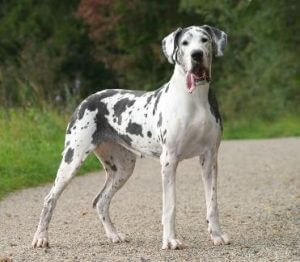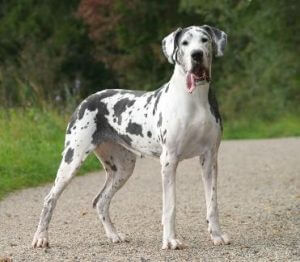It’s just after dinnertime, and the doorbell rings. You suddenly have unexpected company, and your dog is excited as you are. It is at times like this it is of vital importance to remember one of the risks and dangers associated specifically with larger breed dogs, Gastric Dilitation Volvulus, or bloat, as it is commonly called.
Bloat is a condition where a dog’s stomach fills with gas and begins to twist out of place. What you will see is vomiting or retching, with nothing coming up, and the dog’s stomach getting larger in size. The most frequent times this condition occurs is after the dog has eaten (and has a belly full of food and water), and then goes out through the dog door, or runs around and gets excited (such as with company), and all this activity causes the stomach to swing and slosh inside the dog, and eventually twist. Dog’s at highest risk are large and with a deep chest, like Rottweilers, Great Danes, German Shepherds, and similar.

If you suspect this has happened to your dog, they need to go to an emergency hospital, right away! Do not wait! If you notice the above signs, get your dog to the nearest vet as quickly as possible. There they can pass a tube into the stomach to relieve the gas build up, and/or possibly do surgery to correct the displacement and restore the blood flow cut off to vital parts of the stomach and intestines before it’s too late. Bloat in dogs is always a potentially life threatening emergency.
Some people who adopt larger dogs, choose to have a surgical procedure called a “pexi” for short, performed, which tacks the stomach to the inside wall of the chest so it cannot flip out of place (or at least greatly minimizes the chance of this happening). A great time to do this is in female dogs during their spay surgery. Ask your vet about it if you have a large, deep chested dog.
So how do we minimize the risk of bloat?
- Feed your dog smaller meals
- Keep your dog’s activity level to a minimum after eating
You can also:
- Consider a ‘pexi’ surgery for prevention
- Don’t allow your dog free access to the dog door after meals
- Feed a high quality, all natural diet. It might not specifically lower the risk for bloat, but it will help keep your dog healthier, for longer.
This is a disease process that can occur at any age, although it is most commonly noted in middle aged to older dogs. There is no direct genetic predisposition that has been confirmed. There are no specific geographic locations, or ambient temperatures which contribute to bloat occurring more often. In high temperatures a panting dog is not necessarily at any higher risk, as they do not swallow air when panting. However, if the dog is frantic, and anxious because it is so hot, she may pace around trying to find relief from the heat, and after a meal, this could cause it to seem as if there is a link between high heat, panting, and bloat. The key is to always keep the dog quiet after eating, and not letting them drink a huge amount of water and then exercise.
That means when that unexpected company shows up right after dinner, be sure to FIRST put the dog in her crate, so she can remain calm and not accidentally jump around with excitement. In my experience, there has been a higher incidence of cases of bloat after the dog went out the dog door, and no one really noticed what activity the dog was doing for a short time. I did the ‘pexi’ surgery on both my last two female dogs, during their spay surgeries. Luckily I have not had to experience this horrific event with any of my dogs, and I wish the same for you.
On that note, I am DrQ, housecall veterinarian, here to help you, in Denver, Colorado and around the world, to have the healthiest, longest relationship with your animals, than you ever thought possible. Thanks for reading! Please share if you found this helpful!

